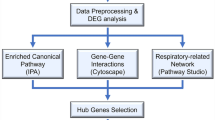Abstract
The problems of analyzing dose effects on gene expression are gaining attention in toxicological research. Determining how gene expression profiles change with toxicant dose will improve the utility of arrays in identifying biomarkers and elucidating their modes of toxic action. In the present study, we focused on determining the dose-dependent alterations of gene expression profiles with hexanal exposure and we identified the possible biomarkers of hexanal in A549 human alveolar cells. A549 cells were exposed to a 5% inhibitory concentration (IC5) and a 20% inhibitory concentration (IC20) of hexanal for 48 h. Through microarray analysis using an oligonucleotide chip, we identified that the gene expression patterns were differentially shown in the control group and the hexanalexposed groups. The hexanal-exposed groups are more sensitive to gene alteration than the control group, and gene expressions are more significantly altered in the IC20 exposure group than in the IC5 exposure group. With clustering analysis of gene expression profiles, we identified 2,929 IC5− and 3,678 IC20-specific genes, and 302 dose-dependently expressed genes. Gene ontology (GO) analysis with 246 annotated genes of the 302 dosedependent expressed genes showed correlation with the key biological processes involved in neurological system processes, immune system development, cell activation, and cell-cell signaling. In conclusion, current study describes alterations in gene expression profiles in response to exposure to different doses of hexanal and related toxic pathways induced by significantly expressed genes. Moreover, novel genes and pathways that could potentially play a role in the prevention of respiratory disease due to aldehydes are identified.
Similar content being viewed by others
References
Bruce, N., Perez-Padilla, R. & Albalak, R. Indoor Air Pollution in Developing Countries: A Major Environmental and Public Health Challenge. Bull WHO 78, 1078–1092 (2000).
Zhang, J. & Smith, K.R. Indoor air pollution: a global health concern. Br. Med. Bull. 68, 209–225 (2003).
Hodgson, A.T., Rudd, A.F., Beal, D. & Chandra, S. Volatile Organic Compound Concentrations and Emission Rates in New Manufactured and Site-Built Houses. Indoor Air 10, 178–192 (2000).
Lewis, C.W. & Zweidinger, R.B. Apportionmnent of residential indoor aerosol, VOC and aldehyde species to indoor and outdoor sources and their source strengths. Atmos. Environ. 26, 2179–2184 (1992).
Hodgson, A.T., Beal, D. & McIlvaine, J.E.R. Sources of formaldehyde, other aldehydes and terpenes in a new manufactured house. Indoor Air 12, 235–242 (2002).
O’Brien, P.J., Siraki, A.G. & Shangari, N. Aldehyde Sources, Metabolism, Molecular Toxicity Mechanisms, and Possible Effects on Human Health. Crit. Rev. Toxicol. 35, 609–662 (2005).
Zhang, J., Lioy, P.J. & He, Q. Characteristics of Aldehydes: Concentrations, Sources, and Exposures for Indoor and Outdoor Residential Microenvironments. Environ. Sci. Technol. 28, 146–152 (1994).
Corradi, M. et al. Aldehydes in Exhaled Breath Condensate of Patientswith Chronic Obstructive Pulmonary Disease. Am. J. Respir. Crit. Care. Med. 167, 1380–1386 (2003).
Hamadeh, H.K. et al. Gene Expression Analysis Reveals Chemical-Specific Profiles. Toxicol. Sci. 67, 219–231 (2002).
Te Pas, M.F. et al. Biochemical pathways analysis of microarray results: regulation of myogenesis in pigs. BMC Dev. Biol. 7, 66–80 (2007).
Osachoff, H.L., van Aggelen, G.C., Mommsen, T.P. & Kennedy, C.J. Concentration-response relationships and temporal patterns in hepatic gene expression of Chinook salmon (Oncorhynchus tshawytscha) exposed to sewage. Comp. Biochem. Physiol. Part D Genomics Proteomics. 8, 32–44 (2013).
Naciff, J.M. et al. The genomic response of Ishikawa cells to bisphenol A exposure is dose- and time-dependent. Toxicology 270, 137–149 (2010).
Feltens, R. et al. Chlorobenzene induces oxidative stress in human lung epithelial cells in vitro. Toxicol. Appl. Pharmacol. 242, 100–108 (2010).
Koehler, C. et al. Aspects of nitrogen dioxide toxicity in environmental urban concentrations in human nasal epithelium. Toxicol. Appl. Pharmacol. 245, 219–225 (2010).
Roggen, E.L., Soni, N.K. & Verheyen, G.R. Respiratory immunotoxicity: an in vitro assessment. Toxicol. In Vitro 20, 1249–1264 (2006).
Kelada, S.N., Eaton, D.L., Wang, S.S., Rothman, N.R. & Khoury, M.J. The Role of Genetic Polymorphisms in Environmental Health. Environ. Health Perspect. 111, 1055–1064 (2003).
Pleil, J.D. Role of Exhaled Breath Biomarkers in Environmental Health Science. J. Toxicol. Environ. Health B Crit. Rev. 11, 613–629 (2008).
Hood, E. Metals leave their mark: fingerprints of lowdose exposure. Environ. Health Perspect. 111, A348 (2003).
Yona, S., Lin, H.H., Siu, W.O., Gordon, S. & Stacey, M. Adhesion-GPCRs: emerging roles for novel receptors. Trends Biochem. Sci. 33, 491–500 (2008).
Daaka, Y. et al. Essential Role for G Protein-coupled Receptor Endocytosis in the Activation of Mitogenactivated Protein Kinase. J. Biol. Chem. 273, 685–688 (1998).
Gutkind, J.S. Regulation of Mitogen-Activated Protein Kinase Signaling Networks by G Protein-Coupled Receptors. Sci. STKE. 2000, re1 (2000).
Herlaar, E. & Brown, Z. p38 MAPK signalling cascadesin inflammatory disease. Mol. Med. Today 5, 439–447 (1999).
Kumar, S., Boehm, J. & Lee, J.C. p38 MAP kinases: key signalling molecules as therapeutic targets for inflammatory diseases. Nat. Rev. Drug Discov. 2, 717–726 (2003).
Mosmann, T. Rapid colorimetric assay for cellular growth and survival: application to proliferation and cytotoxicity assays. J. Immunol. Methods 65, 55–63 (1983).
Author information
Authors and Affiliations
Corresponding author
Rights and permissions
About this article
Cite this article
Cho, Y., Song, MK., Choi, HS. et al. Analysis of dose-response to hexanal-induced gene expression in A549 human alveolar cells. BioChip J 8, 75–82 (2014). https://doi.org/10.1007/s13206-014-8202-3
Received:
Accepted:
Published:
Issue Date:
DOI: https://doi.org/10.1007/s13206-014-8202-3



